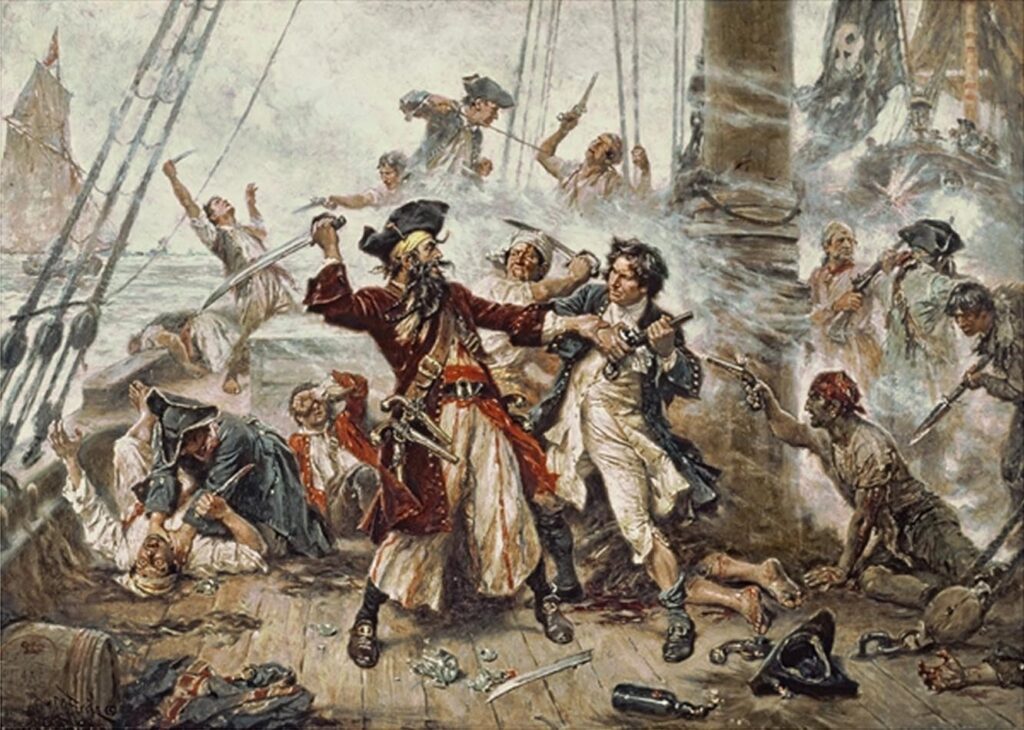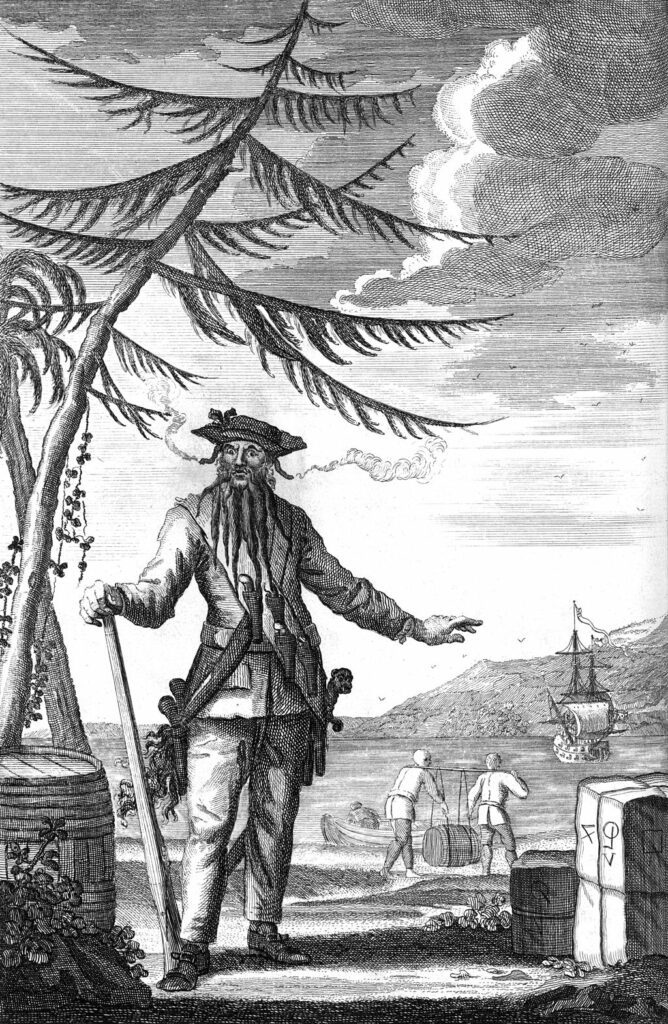A pirate’s life is full of adventure and danger, but with that comes structure and order. Pirates have been a part of the maritime world since the early days of sailing. They have a long and colorful history, and the roles and duties of a pirate in a pirate crew are just as varied as it is interesting.
Let’s look at how these historical misfits operated and the many duties they all had to play aboard their warships, from top to bottom.

Captain
On the face of it, a pirate captain was the leader of a pirate crew and was responsible for planning and guiding the crew’s activities, such as raids and attacks on other vessels, navigation and navigation of the ship, and the management of the crew’s activities.
Contrary to popular opinion, though, pirate captains weren’t dictatorial in their leadership and management. While the captain was indeed the leader of any given pirate crew, the truth is that on most pirate vessels, the captain had little or no authority over the crewmates’ actions in their everyday life.
The pirates were a unique bunch with equal rights and had duties assigned only according to individual ability.

Pirate captains typically earned their keep through respect rather than fear. The crew searched for a qualified candidate to command. The captain also needed bravery and proficiency in sword and pistol combat.
While the captain could punish erring crew members, it wasn’t a solitary decision. The verdict had to be passed by the pirate council — every man on the ship — by a show of hands.
The captain only had absolute control over the crew during battles. In such scenarios, they had full authority to punish those who broke the rules or failed to follow orders. This included ordering crew members flogged, marooned, or even executed.
The captain also bore the responsibility of maintaining the crew morale. They were often charismatic, so these leading figures could rouse the men’s spirit.
Even though the captain didn’t have much say in the men’s daily lives, he was still very much in charge of a basic level of discipline. This included resolving crew member disagreements, ensuring that the crew was treated fairly and equitably, and maintaining a feeling of order and respect.
The captain represented the crew to other vessels and negotiated with other captains or ship owners. Also, the captain was in charge of obtaining safe harbor for the ship and negotiating protection or trading privileges with local pirate authorities.
Quartermaster
In terms of hierarchy, the quartermaster ranked next to the ship captain. However, the quartermaster position was an integral part of any pirate crew. He was the captain’s right-hand man, both literally and figuratively.
A quartermaster couldn’t be just any pirate. The position needed strong leadership and organizational abilities. A quartermaster, like a captain, only could be elected by a majority vote.
That said, the primary duty of a quartermaster on the ship was to oversee the “efficient conduct of daily operations.” The quartermaster assigned tasks to the crew and settled crew member disputes.
They were also responsible for maintaining a good relationship between the crew and the captain and ensuring that the captain’s orders were followed. If a crew member refused to accept orders, the quartermaster could punish them.
Second, only to the ship captain, the quartermaster had second dibs on loots and most other goodies up for grabs. Unlike in the traditional Navy, where the 2nd in command is usually exponentially less powerful, the reverse was the case with pirates. The quartermaster essentially shared power with the captain, with the latter superseding the former in certain situations.
As the captain’s right-hand man, the quartermaster also had an informal duty to watch out for mutiny or rebellious behavior.
Lastly, the quartermaster ensured that the ship was adequately supplied and provisioned. This included ensuring enough food, water, and other supplies for the crew and that the ship was properly maintained and equipped for any eventuality.
Sailing master
The sailing master was responsible for a ship’s overall navigation, sailing, and management. Navigation during the heyday of piracy was based mainly on speculation.
Even after the naval clock was invented in the second half of the 18th century, it was still impossible to accurately identify and calculate longitude.
The Sailing Master had outstanding astronomical knowledge in addition to top-shelf first-hand knowledge of the whereabouts of the major ocean currents. He could identify the precise latitude and travel to his intended location using the stars as a compass.
The position of a Pirate Sailing Master was one of great importance and commanded high respect in any pirate crew. The safety of the cargo and the success of any given voyage chiefly depended on the sailing master’s expertise.
In terms of sailing and navigation, the sailing master was responsible for setting the ship’s course, determining the optimal speed and direction, and managing the crew members in charge of the sails to reach the desired destination.
This included monitoring the weather, seas, and wind conditions to ensure the proper speed and direction of the vessel. In addition, whoever held this position would’ve been familiar with reefs and shoals to steer the ship away successfully.
In terms of managing the crew, the sailing master was responsible for the overall discipline and training of the crew members manning the sails. This included organizing rotations and duties for these men, ensuring that their composure was maintained even in dire situations such as battle and treacherous weather.
Being sail master was an explosive, thankless job that saw the management of a riotous gang of thieves, murderers, and criminals. And as you might expect, a difficult one too. While having the technical qualification was enough, a murderous stare here and there would undoubtedly be a bonus.
Master Boatswain
The Master Boatswain was typically the most seasoned seaman onboard a pirate vessel.
The holder was tasked with keeping the ship in good repair, often requiring the utmost expertise. He answered directly to the captain and the quartermaster.
The boatswain’s duties included supervising the work of the deckhands, maintaining the ship’s rigging, sails, and other equipment, and overseeing the loading and unloading of cargo.
Additionally, the boatswain held responsibility for the crew’s safety by ensuring that the ship was in good repair and that all safety protocols, diminutive as they might be, were well observed. This included inspecting the ship’s hull, rigging, and sails and conducting regular maintenance and repairs.
In chaotic situations, the boatswain became the de facto leader of the ship as they were typically calm, level-headed, and in control of the situation. In the event of external attacks, the boatswain was expected to take charge and lead the crew in defending the ship.
As one of the most experienced pirate personnel on board, the boatswain was pivotal to the pirate culture aboard any given pirate vessel. Not only did he help train newer crew members in the art of piracy, but he was also responsible for the indoctrination of every individual.
Powder Monkey
A powder monkey was a young crew member on a pirate ship — usually a teenager between 11-14 years — responsible for transporting gunpowder from the ship’s storage area to the cannons during battle. They were typically chosen because of their small size, agility, and lack of fear.
The powder monkey’s primary duties involved moving gunpowder up from the ship’s magazine and into the cannons during battle. They needed to be cautious during this process, as any spark or flame could ignite the powder and cause an explosion.
These young boys had to wear non-flammable gear and be extremely cautious when racing over the deck during battle.
In addition to transporting powder, powder monkeys were also responsible for helping to prepare the cannons for battle. They would help swab the guns, load the cannon balls, and ensure the cannons were aimed correctly.
They would also help ensure that the gunpowder was kept dry and secure, as even the slightest moisture could render it useless.
Aside from their duties in battle, powder monkeys were sometimes also expected to help with other tasks around the ship. This could include helping to clean the decks, haul water, and prepare meals. They were also sometimes used as lookouts, especially in more dangerous areas.
Although the role of the powder monkey was treacherous and often short-lived, they were essential to pirate combat. They were a crucial part of the pirate’s success in battle.
Sadly, despite their importance to the pirate lifestyle, they were typically mistreated, underpaid, and disposable. Powder Monkeys had limited chances of advancement and, understandably, frequently deserted.
Gunner
A Gunner’s role in a Pirate crew was crucial. Despite their infamous intimidating presence, a successful Gunner was often a highly skilled and knowledgeable individual with a deep understanding of their weapons and the ability to employ them effectively in battle.
Gunners were in charge of the small-man teams that operated the cannons. They typically did the aiming themselves while leaving the less delicate aspect of the operation to their men.
The primary responsibility of a Gunner was the safe and efficient operation of the ship’s weaponry. Gunners ensured that the ship’s cannons, muskets, and other firearms were functioning correctly and loaded with the correct ammunition.
Becoming a proficient gunner would need years of training. This is because they only got little experience in each gunfight as pirates preferred to cripple other ships rather than destroy them.
They had to do the following; shoot, reset, swab, and load one cannon properly, with the help of about a dozen men. The task was anything but simple and required coordination with other gunners.
Pirates holding a gunner’s position must also be able to identify and repair any issues with the weapons and maintain and clean them regularly.
In addition to their role as weapon technicians, they were also responsible for teaching the rest of the crew how to use the weapons. They had to demonstrate the proper firing techniques and safety protocol and provide instructions on how to reload and maintain the weapons.
Typically, the most seasoned gunner was chosen to serve as a Master Gunner to avoid chaos and haphazard shooting. When the captain was not there, he was the one issuing orders.
After all is said and done, a pirate crew was nothing as simple as usually depicted in popular culture.
While there is some accurate historical reference to the pirates’ lifestyle, we know that they were a complex and fascinating bunch, each with their tasks and responsibilities. By working together, they formed a formidable team and could forge incredible experiences on their sea-faring voyage.

